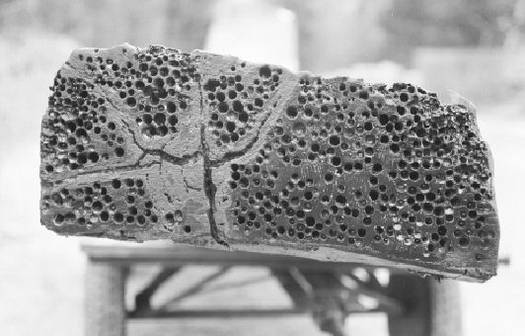Strategies for the protection of shipwrecks in the Baltic Sea against forthcoming attack by wood degrading marine borers. A synthesis and information project based on the effects of climatic changes.

- Sectioned plank showing the numerous holes created by shipworm
Today the Baltic sea is a brackish marine environment, enclosing a unique well preserved historical collection of wooden shipwrecks and settlement sites. These objects and constructions are protected from aggressive marine borers due to the low salinity in the waters, and therefore it is one of the few localities in the world where historical shipwrecks are found so intact and available for historical research. There are, however, strong indications that the marine borer Shipworm (Teredo spp) is spreading into this area. If we are not able to protect the cultural heritage, these objects will be lost within a relatively short time due to their aggressiveness.
A strategy to handle this alarming scenario, is to provide the museums and conservators responsible for long term preservation of cultural heritage, with tools for predicting the spread of marine borers, and efficient methods for protection of the wreck, when the degradation is established
As part of the project the partners are trying to obtain as much information as possible about the evidence of shipworms on marine archaeological sites in the Baltic and methods which have been used to protect sites. This questionnaire is aimed at asking practitioners about their knowledge of seeing wood borer attack in areas where they dive and in particular on shipwreck or other marine archaeological sites. Also how they have tried to protect those sites which are left in situ from attack.
In order to familiarise the reader with shipworm a brief introduction is given followed by a short questionnaire, which we hope you will find the time to answer.
Many thanks in advance and we look forward to hearing from you
David Gregory & Martijn Manders
National Museum of Denmark Dutch Agency for Cultural Heritage
Partners of EC-project WreckProtect
Help create an overview of the possible influence of shipworm in the Baltic.

